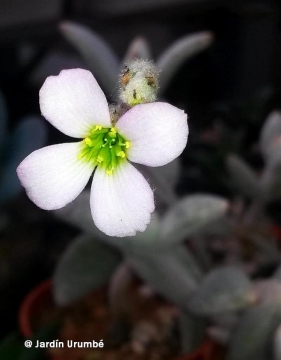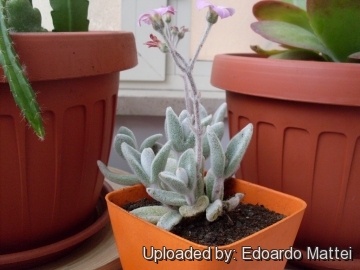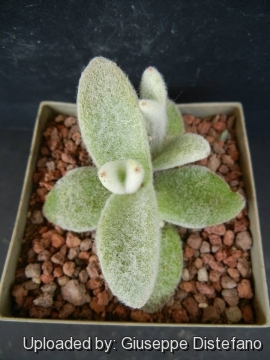
Kalanchoe eriophylla Photo by: Edoardo Mattei
Origin and Habitat: Kalanchoe eriophyllaSN|27475]]SN|27475]] is native to Central Madagascar ( Fedrschenkoi, Ankaratra mountains) where it grows on rocks.
Synonyms:
Common Names include:
ENGLISH: Felt plant, Snow White Panda Plant, Pandaplant, Blue kalanchoe
SPANISH (Español): Kalanchoe peluche
Description: Kalanchoe eriophylla, native to Madagascar, is a pretty succulent plant with slender tomentose stems, and thick-fleshy leaves covered with with a fine felt of whitish hairs that give it a plump, furry look. One of the woolliest of all succulents. It does not flower freely and the small flowers are a rather crude pink. This species is very attractive.
Habit: It is a succulent dwarf perennial bush growing just 3 to10 cm tall with slender tomentose stems branching at the base to form a dense or open mat so that the plant soon gets an untidy look. All parts of the plant are covered with long hairs.
Stems: Main stem creeping to a length of about 30 cm, rooting from the nodes, thin, terete, densely coated, like the leaves on both sides, with a thick mass of white woolly hairs, sending up short leafy branches, some of which terminate in an inflorescence. rather sprawling ... stems
Leaves: Crowded towards the tips of the branches, thick-fleshy, blunt, obovate to oblong, entire, sessile, united at base, decussate, under 2,5 cm long, soft, densely coated on both sides with persistent white hairs, especially the young growth, and with brown spots toward the apex along edge. These hairs give the otherwise green leaves a silvery-white shimmer. The leaves may turn deep crimson when grown in the winter sun.
Inflorescence: Peduncle stiffly erect, up to 30 cm tall, pubescent, furnished only with a single much-reduced leaf above the middle. Flowers few, arranged in a lax simple terminal cyme ; bracts minute, lanceolate; pedicels erect, densely pubescent, about 5 cm long.
Flowers: Tetramerous, pale pink-violet, 4-petalled with yellow centres and very similar to those of Kalanchoe pumila. Calyx campanulate, pubescent in. long ; segments deltoid, acute, longer than the tube. Corolla red-purple, in. long; segments oblong-spathulate, minutely cuspidate, thinly cottony on the outside. Stamens inserted about the middle of the corolla-tube; filaments rather flattened; anthers minute, globose. Carpels with a linear-oblong ovary, narrowed gradually into a subulate style.
Blooming season: Flowers appear in early spring.
Bibliography: Major references and further lectures
1) Baker Kalanchoe eriophylla in: The Journal of the Linnean Society. Botany. volume 18 page 269 1881
2) Gardeners Chronicle & New Horticulturist Haymarket Publishing, page 26 1958
3) Alfred Byrd Graf “Exotica 3: pictorial cyclopedia of exotic plants from tropical and near-tropic regions : 12,000 illustrations, 204 plants in color, guide to care of plants indoors, horticultural color guide, plant geography,” Part 2 Roehrs Co., 1976
 Kalanchoe eriophylla Photo by: Alexander Arzberger
Kalanchoe eriophylla Photo by: Alexander Arzberger Kalanchoe eriophylla Photo by: Giuseppe Distefano
Kalanchoe eriophylla Photo by: Giuseppe Distefano Kalanchoe eriophylla Photo by: Giuseppe Distefano
Kalanchoe eriophylla Photo by: Giuseppe Distefano Kalanchoe eriophylla Photo by: Edoardo Mattei
Kalanchoe eriophylla Photo by: Edoardo Mattei Kalanchoe eriophylla Photo by: Giuseppe Distefano
Kalanchoe eriophylla Photo by: Giuseppe DistefanoSend a photo of this plant.The gallery now contains thousands of pictures, however it is possible to do even more. We are, of course, seeking photos of species not yet shown in the gallery but not only that, we are also looking for better pictures than those already present.
Read More... Cultivation and Propagation: Kalanchoe eriophyllaSN|27475]]SN|27475]] is one of the easiest-to-grow succulents and looks wonderful mass planted in a hot spot in the garden. It needs dry conditions and is not suited to outdoor planting in high rainfall areas because in this conditions it is not such a bright, clean-looking plant as it is when grown indoors, but is very useful in containers in dry places. It makes a good house plant for heated homes. Like most succulents, this plant is tolerant of the dry atmosphere usually found in the home.
Exposition: It needs full sun to light shade, or bright indirect lighting in the home. Bright light for woolliest appearance. However, it should not be subjected to the direct sun of midday.
Soil: It need a porous soil containing about one third grit with adequate drainage.
Repotting: Repot at least every two years.
Hardiness: They need warm temperature and should be kept at a minimum of 10° C. Protect from frost. These plants come from very warm areas and may develop rot if kept too cool.
Waterings: They are drought tolerant, but came from damper climates than most succulents and like more water in the summer. Plants are watered and allow to dry thoroughly before watering again. Like most plants, it will benefit from good ventilation, but should not be exposed to prolonged draughts. During the Autumn and winter months, plants are watered only enough to keep the leaves from shrivelling. This plant will soon begin to rot if kept wet at low temperatures.
Fertilization: Fertilize only during the growing season (Spring and Summer) with a balanced cactus food or one recommended for tomatoes diluted to half the strength recommended on the label.
Pests and diseases: Kalanchoe, like most members of the Crassulaceae family, have succulent leaves which are a great attraction for pests such as Mealy Bugs. While this species is no more prone to attack than others, because of the silvery-white hairy leaves, it is easy to miss the first signs of these pests. Therefore, a regular, careful inspection is sensible. If rot affects the plant, it normally starts at the root... if spotted early, cuttings can be made easily from the tips of the stems to make new plants.
Maintenance: It branches freely to make a prostrate clump. After a while, it can become straggly and should be clipped back to keep it in check and make it neat and tidy. The trimmings make ideal cuttings.
Uses: Grow this Kalanchoe in a rock garden or on a rock wall in mild climates. In cold areas, grow this heat-loving Madagascar native indoors or plant outdoors as an annual.
Propagation: It is propagated by stem cutting or by leaf cuttings in spring or summer. Leaves removed from the plant very carefully will produce small plant in about 4 weeks. Succulent cuttings root easily in moist sandy mix or perlite. Root three or four cuttings together in a single pot to give an almost ‘instant’ plant.















